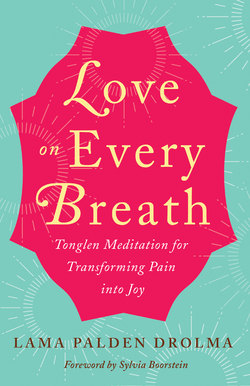Читать книгу Love on Every Breath - Lama Palden Drolma - Страница 8
На сайте Литреса книга снята с продажи.
ОглавлениеForeword
In 2005, I was one of two thousand attendees at a weeklong teaching given by His Holiness the Dalai Lama in Tucson, Arizona. The text for the course was chapter 6 of the Guide to the Bodhisattva’s Way of Life written by the sixth-century Buddhist teacher Shantideva. Chapter 6 is entitled “Patience.” His Holiness read, then translated, then commented on each verse as if it were freshly new and intriguing, even as I was thinking that each verse reiterated the same message: Whatever happens that might arouse negative energy in your mind, expand your perspective so that kindness and compassion is your response. I did also notice that the mood of the room, and my own mood, seemed to become more and more exalted as the week passed, as if we were sharing a space of unshakable benevolence. After His Holiness had read the last verse, he suddenly put his head down between his hands and leaned forward in his seat. When he straightened up, and used his handkerchief to wipe his eyes, we could see that he had been crying.
It was lunchtime of the final day of the conference. We had one more session scheduled for the afternoon. His Holiness then said, “This afternoon we’ll have a bodhisattva vow ceremony. Does anyone have any questions about that?”
A man very far in the back of the room stood up and said, “I am a devout Catholic. Do you think it is okay for me to participate in that initiation?” His Holiness paused for a brief moment and then said, “I think it’s okay.”
We adjourned for lunch and then reassembled in our pre-assigned seats for the final session. Everyone stood up as the Dalai Lama entered, did three full-prostration bows before the Buddha image, and took his seat. I imagined, as I thought everyone did, that he would begin the bodhisattva vow instructions. Instead, he looked to the back of the room where the prelunch question had come from. “I’ve been reflecting more,” he said, “about whether a person who was committed to another religious path should take bodhisattva initiation. And I’m quite sure it is okay. After all,” he concluded, “compassion is compassion and a blessing is a blessing.”
The Tucson conference thirteen years ago still resonates in my mind for what I understand as its two main conclusions. The first, the one that comes when I think of His Holiness’s tears, is the truth that a fully loving heart is the fundamental source of liberation from suffering and of happiness. The second is the recognition, across traditions, that the point and the promise of spiritual practice is developing the human capacity to respond to suffering with wisdom and benevolence.
Love on Every Breath is another translation, interpretation, and presentation of an ancient meditation. In its own way, it moves systematically through all the impediments, the habits of mind and heart, that block the wholehearted expression of love. Lama Palden’s perspective — that of a contemporary Western woman raised in a loving, Christian family who found the fullest expression of her spirituality in the Tibetan Buddhist tradition as a devotee of the venerable Kalu Rinpoche and then as a teacher in two lineages — provides a smooth bridge for today’s seekers to access these teachings. I am particularly heartened to have this book become available right now, at a time when the level of suffering of the world on every level, from global to personal, cannot be ignored. My hope is that it might soothe the hearts of everyone who reads it and encourage them to manifest and teach the possibility of the healing potential of love to everyone around them.
Sylvia Boorstein
October 2018
